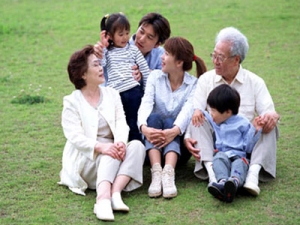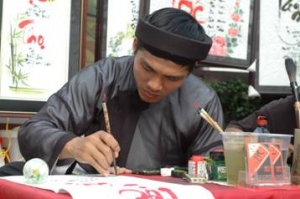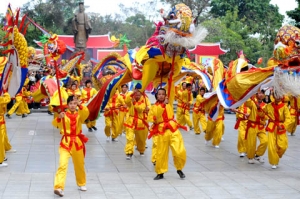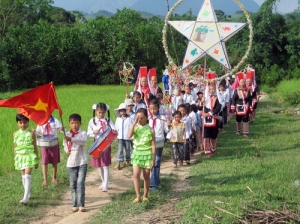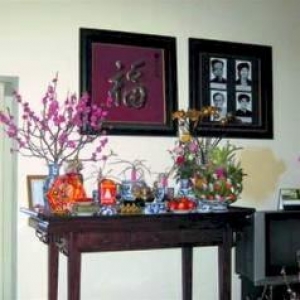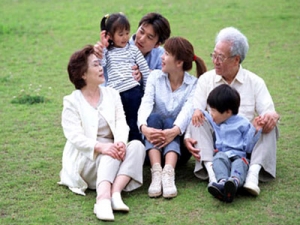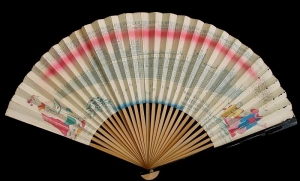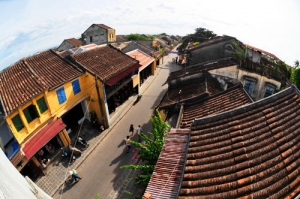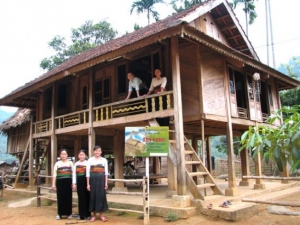
Asia Pacific Travel Team
Family life values in Vietnam
In Vietnam, family is a basic social unit of the society. Vietnamese family life is profoundly influenced by ancestor worship. Children learn at a very early age that they owe everything to their parents and their ancestors. When children do well in school and work hard, they honour their parents and the family name. Respect for parents and ancestors is extended to all elders, whose life experiences are valued.
Marriage and family are very important in Vietnam. In the countryside, parents often arrange marriages; divorce remains uncommon, though is more frequent in cities. In traditional Vietnamese families, roles are rigid. The man of the house is primarily responsible for the family's economic well-being and takes pride in his role as provider. Women are expected to submit to their husbands or to their eldest sons when widowed, and girls to their fathers. Older children help to look after younger siblings. Discipline is viewed as a parental duty, and spanking is common once children are past early childhood.
The woman of the house is referred to as noi tro, "General of the Interior." She looks after her in-laws as well as her parents, husband and children. In rural areas, women also do much agricultural work. Vietnamese women live by the "four virtues": hard work, beauty, refined speech and excellent conduct.
Communism in the 1960's brought big changes for women, who were suddenly given equal economic and political rights, as well as the right to choose their own husband. Years of warfare and dislocation in camps have also altered family roles. With so many men away at war, women took on many traditionally male duties, including managing factories and co-operatives.
Today, more and more people are moving to cities, but most Vietnamese are still farmers. Houses are sometimes built on stilts to avoid flooding. Materials such as earth, straw and bamboo may be used for walls, and red clay tiles or sheets of corrugated metal for roofs. City homes are often made with brick, wood and/or tile.
Vietnamese- Official Language in Communication
Vietnam, S-shaped country, has 54 ethnic groups with different languages. The majority group in Vietnam is the Vietnamese-speaking Kinh and Vietnamese is the official language. Many older Vietnamese are familiar with French or English. Interest in English has been rising, with language schools opening throughout the country.
Like English, Vietnamese uses the Roman alphabet, but otherwise the languages are very different. Every word in Vietnamese has only one syllable, and the language is based on tone. There are up to six tones, and what looks like the same word can have different meanings according to the tone used by the speaker. Tones are high, low, falling or wavering, like notes on a scale. For example, the word ma has six different meanings: "mother" with a high falling tone, "ghost" with a high flat tone, "grave" with a low to rising tone, and so on. In writing, one of five accents (or none) is placed above or below a word's vowel to indicate the tone.
The Vietnamese value modesty and humility about one's accomplishments, and harmonious relations with others. Seeking to avoid conflict in relationships, they often prefer to speak about sensitive subjects indirectly. Outside of large cities, making direct eye contact when talking to someone is considered impolite; similarly, Vietnamese usually speak in a low tone. Although when shopping the Vietnamese barter over prices, this process is done politely; aggression is considered rude.
The Vietnamese sometimes appear to answer "yes" (dạ) to all questions. However, this yes may be a polite way of saying "Yes, I am listening," or "Yes, I am confused," or "Yes, I do not want to offend." Similarly, the Vietnamese smile can be used to show all sorts of emotions, from happiness to anger or even grief. Strong emotions are shared only with family or close friends. Humour, however, is freely expressed.
Traditionally, Vietnamese greet each other by joining hands and bowing slightly; however, in cities some men have adopted the Western practice of shaking hands. In public, men often hold hands as an expression of friendship. Hugging, however, is reserved for relatives.
|
English |
Vietnamese |
|
Hello |
Chào |
|
Please |
Xin làm ơn |
|
Thank you very much |
Cám ơn (bà/cô/ông/em) nhiêù |
|
You're welco |
Không có chi / Không dám |
|
Yes/No |
Dạ/Không |
|
What is your name? |
Tên (bà/cô/ông/em) là gì? |
|
Friend |
Bạn |
Today, more and more foreigners in Vietnam Tourism come to visit this small beautiful land and explore Vietnamese customs and habits, especially they want to know about the diversity of the languages here.
Spiritual Life of Vietnamese People
The richness of Vietnam's origins is evident throughout its culture. Spiritual life in Vietnam, which is totally unscientific, is a belief or practice irrationally maintained by ignorance or by faith in magic or chance. But each nation has its own particular spiritual life. Asia which is a cradle of the world’s culture has a lot of myths, legends of super natural power. Vietnam is one of Asian countries; so there are many superstitious people and culture in the country of Vietnam.
In Asian societies, particularly Vietnamese society, people have a habit of being superstitious and this has been part of their daily life. On such occasions as marriages, funerals and open new house, people will try to choose a propitious date.
Geomacy in building a new house
On the Lunar New Year in Vietnam, people believe that the first person who visits their home during Tet holiday has a bearing on their welfare for the whole year. In contrast, the person who sweeps the floor on the first three days of this festive occasion might sweep away the wealth. As for other things, such as setting out for an examination, embarking on a business venture or planning an escape from Communist Vietnam, people will try to avoid "crossing the path of a woman", in much the same way as Western people would try to avoid "crossing the path of a black cat" when undertaking something important.

Tet Market in Vietnam
The Vietnamese attach great importance to two traditional family obligations: to care for their parents in their old age and to worship them after death. In each Vietnamese family has at least one altar on which there are the pictures of their ancestors. Family members worship their ancestor because they think parents after death will go to live in another world and this altar is the place where the ancestors’ soul live in. As a result, every day, Vietnamese people not only lay the table for meal but they also lay the food on the altar for the belief that those ancestors will have a meal with them.
Spiritual life, sometimes, plays more than a passing role in Vietnamese society. By the time a boy is old enough to marry, for example, he may not be able to wed the girl he loves because she was born in the wrong year. On the 12-year lunar calendar commonly used throughout Asia, many of the years are considered incompatible. Such years are thought to bring misfortune if they are improperly matched with other years. Thus, a young man born in "the Year of the Tiger," cannot marry his beloved from "the Year of the Horse" unless he wants to risk a break in family ties with his parents and elder relatives. To the conservative relatives, the Tiger and Horse are incompatible and sure to bring bad luck to such a marriage. Besides, the hoot of an owl is regarded as a bad omen announcing death or illness. According to ancient tradition, the bird must be chased away and those who heard his cry should be extremely cautious about their personal safety.
What is the best way to keep a child healthy? An old Vietnamese grandfather believes the charm of a certain necklace wards off evil spirits and he may give it to his grandson to protect the boy. An employee fails to show up for work on the third day of the lunar month because he believes that particular date brings him bad luck. A student tries to borrow money to buy lottery tickets because he dreamed of a special event or number one night before. These are some examples of spiritual life which may baffle the foreign visitor to this country. Yet, in Vietnam, it is part of tradition and customs passed down from one generation to the next. Ignorance, of course, plays some roles in the traditional acceptance of spiritual life. Not having sufficient knowledge, faith or trust in scientific methods, a Vietnamese often relies on his prejudices, emotions and the word of his forefathers to guide his daily life.
A large number of fortune-tellers, astrologers and palm-readers owe their living to Vietnamese spiritual life and often made a small fortune from their clients. That the reason why, in Vietnam, even the poor save money for occasional visits to well-known soothsayers. Spiritual life has been known to determine the conduct of the war in this ravaged country. A friendly or enemy commander may refuse to attack or may alter his strategy if the stars are not in his favor.
One story has it that, an American commander always consulted a Vietnamese astrologer before planning the deployment of his troops. When questioned by his incredulous superiors, he explained that, according to his theory, he could depend on the enemy to base his attacks on the positions of the stars. Therefore, he consulted a stargazer himself for intelligence on the enemy's movements.
Another story passed down through history is about of the two famous Vietnamese generals, Le Loi and Nguyen Trai. Several years ago, the pair was leading a war against Chinese invaders. Nguyen Trai decided to turn spiritual life to his advantage and used grease to write the phrases "Le Loi vi Quan; Nguyen Trai vi Than," (Le Loi for King; Nguyen Trai for Minister of State) on the large leaves of forest trees. Ants later consumed the grease absorbed in the leaf tissue and left the prophecy clearly engraved. People living nearby noticed the perforated leaves and interpreted them as a "divine message." Inspired by this, they wholeheartedly supported the war which eventually led to the defeat of the Chinese and the enthronement of Emperor Le Loi.
Some social reformers in the country believe that spiritual life is a problem which should be eradicated as Vietnam is now becoming a truly progressive as well as modern nation. Personally, how dull life would be if all our soothsayers, fortune tellers, palm-readers and astrologers were pensioned off and retired! I promptly took this bad proposition to my favorite soothsayer who solemnly assured me that this is not in the stars.
Mid Autumn Festival for Vietnamese Children
The Mid-Autumn Festival is one of the most exciting and popular holidays for Vietnamese families. It’s also called the “Children’s Festival” and it’s celebrated when the moon is the brightest in the autumn. Parents use this holiday as an opportunity to show their love and appreciation for their children.
It is held on the 15th day of the 8th lunar month annually. On this special day, Vietnamese families plan their activities around their children. In a Vietnamese folklore, parents were working so hard to prepare for the harvest that they left the children playing by themselves. To make up for lost time, parents would use the Mid-Autumn festival as an opportunity to show their love and appreciation for their children.
Appropriately, the Mid-Autumn Festival is also called the Children’s Festival. In the United States, this tradition continues in many Vietnamese-American communities. Trung-Thu activities are often centered on children and education. Parents buy lanterns for their children so that they can participate in a candlelit lantern procession at dawn. Lanterns represent brightness while the procession symbolizes success in school. Vietnamese markets sell a variety of lanterns, but the most popular children’s lantern is the star lantern. Other children’s activities include arts and crafts in which children make face masks and lanterns. Children also perform traditional Vietnamese dances for adults and participate in contests for prizes and scholarships. Unicorn dancers are also very popular in this festival.
Like the Chinese, Vietnamese parents tell their children fairy tales and serve mooncakes and other special treats under the silvery moon. A favorite folklore is about a carp that wanted to become a dragon. The carp worked and worked and eventually transformed itself into a dragon. This is the story behind the mythical symbol, Cá hóa Rồng. Parents use this story to encourage their children to work hard so that they can become whatever they want to be.
There’s also a story about how the Moon Lady ascended to the moon. A man named Chu Coi found a lucky tree that had special healing powers. Because this tree was sacred, people were forbidden to urinate at the foot of this tree. Unfortunately, Chu Coi’s wife, Chi Hang forgot the rule and urinated on the tree. On day, while she was sitting on the tree’s branch, the tree started to grow and grow. Eventually, it reached the moon and since then, Chi Hang lived on the moon for the rest of her life as a punishment for desecrating the sacred tree.
It can be said that the meaning of Mid-Autumn Festival has changed over time. Originally, it’s not a special day for children, but for adult. Today, it’s Children’s Festival and the Mid-Autumn Festival is still a meaningful tradition. It’s the sense of caring, of gratitude, of friendship, of family gathering, and of showing the love. We – Vietnamese citizens should maintain and develop this noble sense.
Vietnamese Family and Social Cultures during the 1980s
Before the late 1980s, most Vietnamese people lived in villages, and the principal economic activity was to cultivate wet rice, the nuclear family including parents and their kids was considered as the basic component of rural society.
In Vietnamese culture, respect for parents and ancestors is a key virtue. The oldest man in the family is the head of the family and the most important family member. His oldest son is the second leader of the family. Sometimes, related families live together in a big house and help each other. The parents chose their children's marriage partners based on who they think is best suited for their child. When people die, their families honor their ancestors on the day of their death by performing special ceremonies at home or at temples and by burning incense and fake money for the one who died.
The Vietnamese believed that by burning incense, their ancestors could protect them and their family from danger and harm. Days before the ceremony starts, the family has to get ready, because they won't have enough time to get ready when the guests arrive and the ceremony starts. Usually the women cook and prepare many special kinds of food, like chicken, ham, pork, rice, and many more including desserts.
While the women are busy cooking, the men are busy fixing up and cleaning up the house, so it won't be messy and dirty because of all the relatives of the person that died will come for the ceremony and show honor and respect to that person. Families venerated their ancestors with special religious rituals. The houses of the wealthy were constructed of brick, with tile roofs. Those of the poor were bamboo and thatch. Rice was staple food for the vast majority, garnished with vegetables and, for those who could afford it, meat and fish.
The French introduced Western values of individual freedom and sexual quality, which undermined and the traditional Vietnamese social system. In urban areas, Western patterns of social behavior became increasingly common, especially among educated and wealthy Vietnamese attended French schools, read French books, replaced traditional attire with Western-style clothing, and drank French wines instead of the traditional wine distilled from rice. Adolescents began to resist the tradition of arranged marriages, and women chafed under social mores that demanded obedience to their fathers and husbands. In the countryside, however, traditional Vietnamese family values remained strong.
The trend toward adopting Western values continues in South Vietnam after the division of the country in 1954. Many young people embraced sexual freedom and the movies, clothing styles, and rock music from Western cultures became popular. But in the North, social ethnics were defined by Vietnam Communist Party’s principles. The government officially recognized equality of the sexes, and women began to obtain employment in professions previously dominated by men. At the same time, the government began enforcing a more puritanical lifestyle as a means to counter the so-called decadent practices of Western society. Traditional values continued to hold sway in rural areas and countryside, where the concept of male superiority remained common.
In the 1980s, the Vietnamese government adopted an economic reform program that freely from free market principles and encouraged foreign investment and development of Vietnam tourism. As a result, the Vietnamese people have become increasingly acquainted with and influenced by the lifestyles in developed countries of South East Asia and the West.
Vietnamese family and its traditional values
In the past, following the extended multi-generational pattern was the tradition of the Vietnamese household. Many generations consisting of the parents, theirs sons, their wives, their children and unwed siblings usually lived under the same roof. Contacting among the family’s members was maintained frequently and this constant closeness to family was emphasized from childhood and continued to be important to Vietnamese throughout their lifetime (Lynell).
Traditional values of Vietnamese lifestyle were deeply affected by Confucian ethics. During thousand years the Chinese invaded and maintained control Vietnam, Vietnamese culture was permeated by their Confucian philosophical beliefs. This philosophy based for the existence of and extended family structure through 2,000 years of Vietnamese history (Lam). It was believed that: ..."in order to achieve human perfection, one must follow the established codes of behavior of Confucianism which include reverence for ancestors and respect for elders...The importance is not upon the individual's accomplishments but upon his duty to family and society" (Muzny).
In the past, following the extended multi-generational pattern was the tradition of the Vietnamese household. Many generations consisting of the parents, theirs sons, their wives, their children and unwed siblings usually lived under the same roof. Contacting among the family’s members was maintained frequently and this constant closeness to family was emphasized from childhood and continued to be important to Vietnamese throughout their lifetime (Lynell).
"Most Vietnamese placed more emphasis on their roles, privileges and obligations within this group than on their own individual desires"(Muzny). In this extended family, the most important expectation was respect for the elders. The family decisions were made by the parents and grandparents. The traditional Vietnamese worshipped ancestors as a source of their lives, fortunes, and civilization. The spirits were honored on various holidays and the anniversary of their death (Tran).
For centuries in Vietnam, traditional family values were accomplished by the fulfillment of traditional roles: the role of man and woman as parents. Vietnamese valued their traditional ideal of male superiority. Since the highest status in Vietnamese families is given to the man (father), he had absolute authority in the household. His position as provider for the family was unchallenged. Because he provided the main source of income for the household, he was never expected to work in the kitchen or to cook. After work he returned home and relaxed. As a head of household he had the final decision in all matters, although he might consult his wife or children. In her report, Phung cited that the father, however, had the duty to exercise restraint and wisdom in running his family in order to deserve his respected position. Having a boy in family was a "must" because the eldest son would assume the duties of his father when he died. A family which had no son to continue the process was superstitiously thought to have disappeared forever.
In a patriarchal society, Vietnamese woman had limited rights and took a secondary place in family. Women were brought up according to a strict discipline, and have been traditionally less educated than men. They usually do not enter the job market outside the home. "Girls from birth were at a disadvantage". Daughter is not considered necessary in heritage. According to Lam, Vietnamese traditional viewpoint was "If you have a son, you can say you have a descendent. But you cannot say so even if you have ten daughters".
After marriage, woman became housewife and mother. She was expected to be dependent upon her husband, budgeted his income for the household, took care of children and even grandchildren, performed all household tasks. According to Muzny, divorce was legal but not common. A wife can be unhappy in her marriage; but rather than accepts divorce, the family encouraged her to sacrifice and to endure the difficulties of the marriage for the sake of her children.
Parental role in family was to define the law. Obedience and respect were the traditional virtues which Vietnamese children were taught to exhibit in the family. Discipline and physical punishment were acceptable remedies for disobedience in the Vietnamese tradition. "Harsh discipline and beatings did not constitute abuse of a child, but its reverse: loving care, concern and attention" (Breeman). When parents grew old, children were expected to take care of them to compensate for the gift of birth and upbringing. The elderly (parents) were supported by married or unmarried children until they die (John).
"Boys and girls are not free to do what they want. Girls are under strict supervision" (John). Western style courtship and romance were seen as inappropriate for unmarried children. "Virginity is cherished. Pregnancy out of wedlock is uncommon, and it is a grave disgrace to the family" (Muzny). For their children's marriage, parents generally made decision because they could judge better. Vietnamese parents had a high regard for education. It was considered a way for family advancement. Parents encouraged their children to study and excel in their education. Vietnamese placed a higher value on education rather than on material success. In brief, "Depending upon the family for financial support, requesting permissions for expenditures, and having parents make decisions for them characterized the traditional Vietnamese child" .
Vietnamese Expression Culture in Non-verbal Communication
Non-verbal communication plays an important role in Vietnamese society, sometimes to accompany and reinforce linguistic symbols, sometimes as a substitute for words. Visitors in Vietnam tourism will be interested in this type of communication, non-verbal behaviors and their meaning in Vietnamese culture when talking with Vietnamese people.
In a previous article, it was pointed out that respect is the cornerstone of interpersonal relationships in Vietnamese society. Respect is conveyed by the use of special terms of address and certain stylistic devices. But respect is also expressed by nonverbal behavior. A Vietnamese student who sits quietly and listens attentively to the teacher wants to express respect to his teacher. This behavior has often been misinterpreted by the American teacher as passivity and non-responsiveness. It is also out of respect that the Vietnamese student avoids eye contact with the teacher when speaking or being spoken to. By American standards, a person acting in this way would appear suspicious, unreliable, or mischievous. In Vietnamese culture, however, looking into somebody's eyes, especially when this person is of a higher status (in age or in social or family hierarchy) or of a different gender, usually means a challenge or an expression of deep passion. The proper respectful behavior is to avoid eye contact in talking who is not an equal or the same sex.
The smile, which is sometimes enigmatic to the American observer, is another nonverbal symbol conveying the feeling of respect in Vietnamese culture. It is used as an expression of apology for a minor offense, for example for being tardy to class, or as an expression of embarrassment when committing an innocent blunder. For the Vietnamese, the smile is a proper response in most situations in which verbal expression is not needed or not appropriate. It is used as a substitute for "I'm sorry", "Thank you" or "Hi!" It is used instead of a ready yes to avoid appearing over-enthusiastic. A smile is also a proper response to scolding or harsh words that one does not harbor any ill feelings toward the interlocutor or that one sincerely acknowledges the mistake or fault committed.
It should be noted that for certain feelings, Vietnamese culture prefers non-verbal communication while American culture is more inclined to use verbal expression. For casual and informal circumstances, feelings of thankfulness or apology are not expressed by verbal expression such as "thank you" or "I'm sorry" but by non verbal, silence or a smile. Parents and teachers never say thanks to their students for a small service, such as closing the window or passing the books around. A smile will do in this case. The person who gives a compliment never expects a "thank you" in return. In Vietnamese culture, a verbal expression of thanks in this case amounts to a lack of modesty from the person who receives the compliment.
A smile or a blush in the face is the proper response to a compliment. If a verbal response is necessary, one would deny the compliment, saying that one does not deserve it. Because of difference in the mediums used to express the feelings of appreciation or apology in the two cultures, misunderstandings have occurred.
The Meaning of Some Patterns of Vietnamese Non-verbal Communication
|
Nonverbal Patterns |
Meaning in Vietnamese Culture |
|
Nodding |
Greeting; affirmative reply; agreement. |
|
Shaking one's head |
Negative reply; disagreement. |
|
Bowing |
Greeting; great respect. |
|
Touching child's head |
Not appreciated, but not offensive. |
|
Avoiding eye contact. |
Showing respect to people senior in age or status or of the opposite sex. |
|
Winking. |
Not decent, especially when directed at people of the opposite sex. |
|
Frowning |
Showing frustration. anger. or worry. |
|
Pouting. |
Disdain. |
|
Smiling. |
Agreement; embarrassment; disbelief; mild disagreement; appreciation; apology. |
|
Shaking hands. |
Friendly greeting between men (but not the elderly); not customary between women or between a man and a woman; acceptable between a Vietnamese woman and non-Vietnamese man. |
|
Palm of right hand out, fingers moving up and down several times. |
"Come here." Not used to people senior in age or status. |
|
Middle finger crossing over forefinger or forefinger crossing over middle finger with the other fingers closed over the palm. |
Obscene gesture. |
|
Middle finger pointing, other fingers closed. |
No meaning. |
|
Thumb down, other fingers closed. |
No meaning. |
|
Thumb upright, other fingers closed. |
No meaning. |
|
Forefinger and top of thumb meet to form circle, other fingers upright. |
"Zero." Poor quality. |
|
Palm of right hand facing oneself, forefinger crooked and moving back and forth. |
Offensive to adults; threatening to children. |
|
Holding hands with or putting an arm over the shoulder of a person of the same sex. |
Friendly gesture, no sexual connotation |
|
Holding hands with or putting an arm over the shoulder of a person of the opposite sex. |
Not usually done in public. |
|
Crossing arms. |
Sign of respect. |
|
Placing one or both hands in the pockets or on the hips while talking. |
Arrogance, lack of respect. |
|
Patting a person's back, especially those senior in age or status. |
Disrespect. |
|
Pointing to other people while talking. |
Disrespect, threatening. |
|
Whistling at performers. |
Displeasure. |
|
Putting one's feet on a table or sitting on a desk while talking. |
Rude |
Vietnamese paper fan
Besides seven prized objects in every household listed as a gourd bowl, a quill pen, a Ty Ba (four-string guitar), an orchid, a chess-set, a sword and a feather-duster, the paper fan in Vietnamese tradition was an indispensable items in days of yore. Today, the traditional paper fan is still widespread and familiar in daily life of Vietnamese people, especially in traditional art performances.
 The famous paper fan-making village in Vietnam is Thach That in the northern province of Ha Tay (now part of Hanoi)
The famous paper fan-making village in Vietnam is Thach That in the northern province of Ha Tay (now part of Hanoi)
Fans are of course common throughout the East. But what makes Vietnam's decorative fans of the hand-held variety different from those made in China or Japan is the angle: in the latter countries, fans typically open to more than 180 degrees, whereas Vietnam's are less than 180. If you look into Vietnamese fans, you can imagine it like a sun shining.
Part of what makes these fans art pieces are the paintings and drawings on the surface, which typically include the traditional Han Nom characters, the country's original script, for Heaven, Land and People, which, combined, are said to symbolise prosperity.
The most important parts of each fan were its two main slats, which form its frame. The material for these slats must be the strongest and most elastic bamboo possible.
The surface of a fan is made of Do paper, derived from bamboo, and silk. Once finished, the surface is then painted, usually using a mixture of dark red, black, yellow, brown and violet - all colours seen in ancient fans.
Nowadays, Vietnamese paper fan is used not only in dailylife but also in traditional art performances because in the past, paper fan is an indispensable decorative item in royal life. Paper fans represent a living tradition for an ancient and beautiful art form.
Hanoi and Hoi An’s Ancient Architectural Styles and Their Beauty
Together with Hoi An ancient town of remarkable architectural styles, Hanoi is Vietnam's only city where the tourists in Vietnam tourism can be attracted by the beauty of the old quarter- Hanoi 36 old streets and guilds. These streets still keep the same appearance as they had at the end of 19th century. According to historical sources, they have been the true core of Thang Long since it was founded a thousand years ago.
 Hanoi's old quarter
Hanoi's old quarter
The area occupied by these ancient streets forms a triangle with its top at Hang Than street and its base at the axis of Hang Bong - Hang Gai - Cau Go street, the eastern side being a section of the Red River Dyke and the eastern side being Hang Cot, Hang Dieu, and Hang Da streets.
Prior to the French colonial period these streets all had the same appearance and were laid out in an order similar to a chessboard; most of them were named after the goods manufactured or sold there. For instance, Hang Duong means "Sugar Street", Hang Bac - "Silver Street", Hang Bo - "Bamboo Basket Street".
The houses in these streets are  called tunnel houses, this is because the house has the shape of a tunnels, being very long and narrow, it sometimes opens at the back into another street, which is different from that of the front entrance door. All the houses are similarly arranged with their front rooms serving as places where goods are manufactured or sold, with small open courtyards to let light in, usually decorated with ornamental rocks, little water-pools with gold fish, ornamental plants and flowers. The backrooms serve as the living quarters with a dining room and bedroom. Most of these houses are covered with small tiles which have the characteristic feature of: two walls of the gable being built so that they are higher than the roof, resembling a staircase with two funny pinnacles.
called tunnel houses, this is because the house has the shape of a tunnels, being very long and narrow, it sometimes opens at the back into another street, which is different from that of the front entrance door. All the houses are similarly arranged with their front rooms serving as places where goods are manufactured or sold, with small open courtyards to let light in, usually decorated with ornamental rocks, little water-pools with gold fish, ornamental plants and flowers. The backrooms serve as the living quarters with a dining room and bedroom. Most of these houses are covered with small tiles which have the characteristic feature of: two walls of the gable being built so that they are higher than the roof, resembling a staircase with two funny pinnacles.
They are mostly one-storied houses, few have second storey. They are generally low and have small or no windows, which arose because according to ancient rules under the past dynasties, inhabitants were forbidden to look at the king when he happened to pass their houses, and they were especially forbidden to look at him from a higher place.
Therefore, tunnel houses are simple and narrow serving both as a place of manufacturing or selling products and as a dwelling house for the family. In these streets, the shops are open all day long, and even in the evening, the quarter is always interesting to walk around. This community of people shares the same fate and they are all united by feelings of solidarity.
Scattered among these ancient houses are many pagodas and temples. These were the place of worship for the ancient villages and guilds. For instance, the temple situated at 38 Hang Duong street, served the inhabitants of Duc Mon village which used to occupy a part of Hang Duong street, and the Huyen Thien pagoda at 54 Hang Khoai street, belonged to Huyen Thien village, which used to occupy the territory of Hang Khoai street. These architectural sites also reflect the origin of Hanoi's inhabitants, most of them coming from other parts of the country, for example: Hoa Loc Temple at 90 Hang Dao street, was founded by a guild of dyers natives of Dan Loan in Hai Hung province, Tu Thi Temple at 2A Yen Thai Alley, was dedicated to the worship of the patron saint of embroiderers, and built by a villager of Quat Dong in Ha Tay province (now part of Hanoi) who lived by the trade of embroidery. However, on the other hand, the existence of these pagodas and temples testifies to the intense spiritual life of the inhabitants of old Hanoi, who lived in harmony with nature, society and the spiritual world. Thus, today the city’s material world coexists with a sacred legendary world, the present and the past intermingle, creating a long lasting strength.

Lang pagoda in Hanoi
The ancient streets have undergone some alterations owing to historical upheavals, social adaptation and the appearance of some new construction, but they still remain virtually unchanged. So this is why this area with small tunnel houses, crowded streets, pagodas and temples, with curved roofs and green trees, all gives


Hanoi it’s own particular original beauty.
Since the end of the 80s with the implementation of the renovation policy, economic life has improved, commerce developed and many houses in the ancient streets have been demolished, repaired or rebuilt and often concrete 3 or 4 storied houses have replaced the old ones. The area of ancient streets has gradually been losing the beauty of its traditional architecture.
Yet, in spite of the alterations and construction, this area still represents a precious legacy left to Hanoians, to be handed down to future generations. This is why now Hanoi's municipal administration is studying the feasibility of a project to renovate this ancient area.
As a result of an online poll conducted by Smart Travel Asia magazine, Hanoi and Hoi An town are rated among the top ten best destinations in Asia for 2011. It is the beauty of their ancient architectural styles that attracts more visitors who join tours to Vietnam in order to explore the ancient beauty of two cities.
Stilt Houses in Vietnamese Tradition
Traditional stilt houses of Vietnamese people built four thousand years ago were similar to those in use today. Because these stilt houses are suitable to flood-prone plains and to steep mountain slopes, they are still popular among many of Vietnam's 54 different ethnic groups.
As well as being somewhere to eat, entertain and sleep, a stilt house is where a family worships its ancestors and works at tasks like weaving and embroidery. The most important room is the kitchen, which is usually set in the center of the house and serves as a meeting place where the family gathers at the end of the day.

On the lower level of a Thai house, the family entertains guests, cooks and weaves.
Stilt houses are made from wood, bamboo, cane, or rattan. A traditional stilt house typically has an area for drying rice, set one or two steps below the main level. The area under the house is either unused or used as a pen for livestock.
Tay and Nung people in northwestern Vietnam (including Lang Son and Cao Bang) typically build their stilt houses up against a slope. Ideally, the front of the house should overlook fields; close views of mountains, rivers and forests are avoided. The Tay and Nung believe that a mountain peak is like an arrow, which, if pointed at a house, might injure its residents. Trees, meanwhile, are associated with fierce beasts, and thought to bring bad luck to livestock. Nearby streams are thought to cause money to flow away from a house.

Xa pho ethnic minority's stilt house
Tay and Nung houses are usually narrow in front and supported by seven or nine rows of columns running along the sides. Villages typically consist of houses set parallel to each other along a hillside.
Since Viet people traditionally lived on flat, spacious plains, their stilt houses are wider. A typical Viet stilt house has two staircases on the left and right sides. The walls are made from thin boards. The roof rests on one or two pillars and two beams. The right side of the house is used for worship, entertaining guests and the men's quarters, while the left side is reserved for women

Muong ethnic minority's stilt house
Muong people build stilt houses that include characteristics of Viet, Tay and Nung houses, while Thai people have a very distinctive house style. All houses in a Thai village face high mountains and forests, since this view is thought to increase vitality. It is considered unlucky to build a house facing a gap between two mountain peaks.
Like other groups, the Thai position their houses facing north to south. They divide the living space into two: a higher level, restricted to family members, is used for worship, relaxation, and sleep; the lower level is where the family entertains guests, cooks and weaves. There are two doors and two covered porches. The left-hand door is called chan and the right-hand door is called quan. Family members may use both doors, but visiting women must use the chan door, while visiting men must use the quan door.
A new son-in-law sleeps in the right porch, which is called the tang quan. The left porch, or tang chan, is used for drying rice and clothes. Thai houses have beautiful windows, measuring 60cm by 100cm, set close to the floor in the front wall. The roofs are highly distinctive in that they are comprised of four panels. Two flat panels are linked by curved gables over the porches.
Bana, Xedang, and Giarai people living in Vietnam's Tay Nguyen (Central Highlands) build huge stilt houses known as rong. The roof of a rong is incredibly steep and tall, like the blade of a hole. In front of a rong stands a balcony. These stilt houses serve as communal halls.ff
The Ede, a matriarchal group in Dak Lak province, live in stilt longhouses. The homeowners' bedroom faces east, while the guest room faces west. The roof is highly unusual in that it is trapezoid-shaped, with the longer end at the bottom.
This roof is supported by columns and extends from one to one-and-a-half meters in the front and back.
The interior is equally strange, as the roof is so tan and narrow. Most of the house is taken up with the living room, supported by four columns: the master column, guest column, drum column and gong column. Guest seating entails benches made from old trees, 27 to 30 meters in length, which are intricately carved.
Whatever their style and size, Vietnam's traditional stilt houses complement their natural settings. Simple and unimposing, these houses reflect the unique cultures of Vietnam's diverse ethnic groups.


